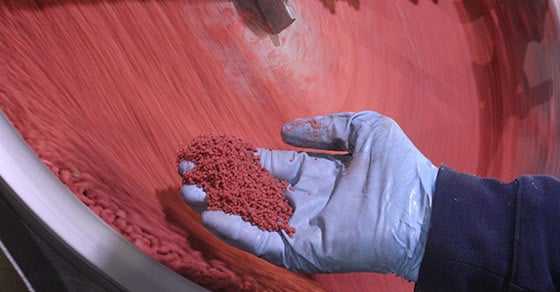With a host of benefits, disc pelletizers (also known as pan granulators) are increasingly being used in industries ranging from chemicals to minerals, but they can seem problematic if operators aren’t familiar with the underlying principles of agitation agglomeration and how the disc pelletizer works.
While many operators have learned through trial and error what works in their specific pelletizing plant, arming them with the right skills and knowledge through pelletizer training can significantly improve the process and contribute to the bottom line.
Here are seven reasons to train disc pelletizer operators.
How a Disc Pelletizer Works
First, let’s take a look at how the disc pelletizer works, as this is important in understanding the need for training.
The disc pelletizer is known for its flexibility in allowing operators to fine-tune process variables during production to improve product quality and yield.
As a type of agitation agglomeration (wet granulation) equipment, disc pelletizers form granules through the use of motion and a liquid binder. To accomplish this, the disc pelletizer consists of a rotating disc set on an adjustable angle, affixed to a stationary base. A liquid spray system distributes binder over the rotating disc, which causes material fines to become tacky and come together. These newly formed “seed pellets” continue to move around the disc courtesy of centrifugal force, passing through the spray and feedstock streams. As they do this, the tacky seed pellets pick up additional fines. As they continue to roll along the disc, this creates a constant layering effect similar to rolling a snowball, known as coalescence.
To reach the desired particle size, crush strength, and other parameters, operators have a number of process variables at their disposal, which, when properly managed, give operators precision control.
For the novice, however, the number of variables, as well as how they interact, can be a challenge in mastering granule formation and refinement.
As such, training disc pelletizer operators gives plant managers the opportunity to:
1. Maximize Productivity
One of the key advantages of the disc pelletizer is that it allows operators to optimize the amount of on-size product coming off the disc. This is done through the adjustment of several process and equipment variables, most notably:
- Binder spray rate
- Number and location of spray nozzles
- Feed rate and location
- Disc speed
- Disc angle
- Plow/Scraper location
By making careful adjustments to these variables, operators can maximize the on-size product yield, which could even translate to fewer required operating hours.
2. Improve Efficiency
By knowing how to optimize the process for maximum yield, operators are also able to improve overall plant efficiency. This typically leads to lower labor costs, reduced downtime and maintenance costs, fewer process upsets, and a decrease in the amount of lost product, among other benefits.
This improvement in efficiency can also extend to downstream production processes and equipment as well, allowing operators to optimize product characteristics to meet specific processing requirements. It can also reduce the amount of off-spec product being processed, which in turn lowers associated energy costs.
3. Enhance Product Quality & Control Particle Characteristics
Whether the granules will serve as a finished or intermediary product, the capability of a disc pelletizer operator to enhance product quality is always beneficial.
The flexible nature of the pelletizing process, combined with a well-trained operator, provides control over particle characteristics such as particle size distribution (PSD), crush strength, moisture content, attrition, flowability, and more.
4. Improve In-House Troubleshooting Capabilities
Perhaps one of the greatest advantages to training disc pelletizer operators is giving them the ability to troubleshoot issues and even anticipate and avoid potential problems. Operators can minimize downtime by systematically and efficiently troubleshooting any issues that may arise.
5. Promote Equipment Longevity
Proper operation of equipment is a significant contributor to the longevity of equipment, and disc pelletizers are no exception. A properly operated disc pelletizer is much less likely to experience issues and premature failure.
6. Boost Employee Engagement and Morale
Workplace training in general can provide a number of benefits, such as increased job satisfaction for employees and reduced turnover. The same can be said of a disc pelletizer operator.
Properly trained disc pelletizer operators are less likely to struggle with day-to-day operations and more likely to feel a sense of accomplishment and contribution to their work.
7. Reduce the Potential for Workplace Accidents
While disc pelletizers aren’t known for being especially dangerous, they are still a piece of industrial equipment made up of moving parts. Any type of industrial equipment presents some level of inherent risk, and training operators is the first step to minimizing the potential for accidents.
Conclusion
Training for disc pelletizer operators is a valuable tool in maximizing product quality, productivity and efficiency, and minimizing downtime, lost product, and equipment issues, among other critical objectives.
As the industry’s leading disc pelletizer and agitation agglomeration expert, FEECO offers the industry’s best training for disc pelletizer operators, helping plant managers to improve efficiency and productivity, while empowering operators to more effectively manage the pelletizing process.



